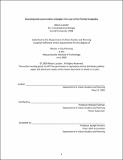| dc.contributor.advisor | Michael Flaxman. | en_US |
| dc.contributor.author | Lassiter, Allison (Allison Blythe) | en_US |
| dc.contributor.other | Massachusetts Institute of Technology. Dept. of Urban Studies and Planning. | en_US |
| dc.coverage.spatial | n-us-fl | en_US |
| dc.date.accessioned | 2009-11-06T14:49:09Z | |
| dc.date.available | 2009-11-06T14:49:09Z | |
| dc.date.copyright | 2009 | en_US |
| dc.date.issued | 2009 | en_US |
| dc.identifier.uri | http://hdl.handle.net/1721.1/49536 | |
| dc.description | Thesis (M.C.P.)--Massachusetts Institute of Technology, Dept. of Urban Studies and Planning, 2009. | en_US |
| dc.description | This electronic version was submitted by the student author. The certified thesis is available in the Institute Archives and Special Collections. | en_US |
| dc.description | Includes bibliographical references (leaves 66-70). | en_US |
| dc.description.abstract | South Florida's Everglades is home to 67 threatened and endangered species. By 2100 it is estimated that sea level rise will inundate over 20% of existing conservation lands. Species will be dislocated and migrate to new land. Simultaneously, more than 500,000 people are moving to the region annually. The new populations are subdividing and developing rural lands. By 2100, it is estimated that over 60% of rural land will be urbanized. In this thesis, I use Geographic Information Systems to project the location of urban land, conservation land and inundated land in South Florida over the next 50 years. I assess fee simple purchase and conservation easements as potential methods of conveying land protection. I conclude that none of the current methods of conservation have the capacity to manage the large scale land protection that will be critical in the coming years, if we are to protect our species from the emergent and significant stressors of climate change and urbanization. I conclude that a major federal initiative based on purchasing deed restrictions and a new agency that specializes in monitoring will be necessary to quickly creating a large, adaptive ecological reserve network. | en_US |
| dc.description.statementofresponsibility | by Allison Lassiter. | en_US |
| dc.format.extent | 70 leaves | en_US |
| dc.language.iso | eng | en_US |
| dc.publisher | Massachusetts Institute of Technology | en_US |
| dc.rights | M.I.T. theses are protected by
copyright. They may be viewed from this source for any purpose, but
reproduction or distribution in any format is prohibited without written
permission. See provided URL for inquiries about permission. | en_US |
| dc.rights.uri | http://dspace.mit.edu/handle/1721.1/7582 | en_US |
| dc.subject | Urban Studies and Planning. | en_US |
| dc.title | Assessing land conservation strategies : the case of the Florida Everglades | en_US |
| dc.type | Thesis | en_US |
| dc.description.degree | M.C.P. | en_US |
| dc.contributor.department | Massachusetts Institute of Technology. Department of Urban Studies and Planning | |
| dc.identifier.oclc | 436281074 | en_US |
